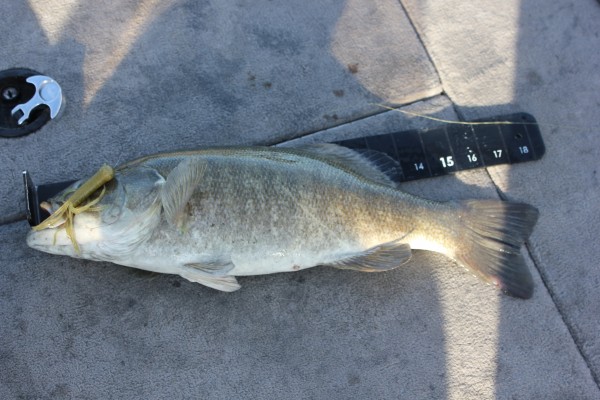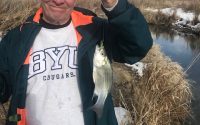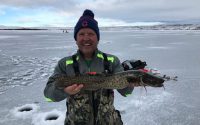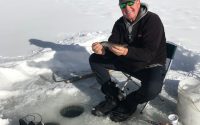Summertime Smallmouths — Timing the Switch
 Smallmouth bass behavior never ceases to amaze. One day the bass are coming off the post spawn period and are protecting fry or simply eating everything in sight … and then … nothing. The bite disappears and the summertime lock jaw begins in earnest.
Smallmouth bass behavior never ceases to amaze. One day the bass are coming off the post spawn period and are protecting fry or simply eating everything in sight … and then … nothing. The bite disappears and the summertime lock jaw begins in earnest.
Why does this happen?
For this post, I can only give you my analysis based on two Utah bass fisheries: Jordanelle, and Flaming Gorge. The reason for sharing information on these specific waters is that they are both reservoirs at roughly the same elevation (6000 ft above sea level). They have different forages bases which plays into the theme of this article. Let’s explore the “disappearing bite” phenominum.
Sometime after the post spawn period in middle to late June on both waters, the bass move into their summer pattern. On Jordanelle, this means the fish move onto the flats near moving water (river inlet) or anywhere wave action creates consistent current. The fish move from shallow to deep and ambush prey on drop offs or in the middle of flooded oak brush left uncut since the reservoir was filled 20 years ago.
Since there is not a significant population of crawdads in Jordanelle, two kinds of minnows make up the bulk of prey species: chubs, and perch. Of course there are trout and bass minnows too but more of the forage are chubs and perch. The smallmouth bass in Jordanelle find areas in the reservoir to ambush prey and to find needed oxygen as the summer heat sends them scurrying to cover.
I have found that the Provo River Arm of the reservoir has a strong current (even in the summer) and therefore provides much needed oxygen and bait fish for the bass. When bass settle into their summer pattern they aren’t nearly aggressive as they were in late spring just before and a couple of weeks after the spawn. At some point, these fish “switch” from aggressively chasing prey to waiting in structure for the prey to come to them. For many anglers this means more snags, line breaks, and at worst few if any bites.
On Flaming Gorge, smallmouth bass are very aggressie during the pre-spawn and post-spawn periods between May and June. Their favorite forage yearround are crawdads, but with a very healthy minnow population they are happy to eat minnows as well. Crankbaits, swimbaits, and flukes, to tubes, grubs, and worms are great lures for springtime and early summer each and every year. But …just when anglers feel they have a handle on the smallmouth during the late spring and into summer … it all changes and bites can be hard if not impossible to come by.
Why?
Like Jordanelle, the “switch” has taken place and the fish have moved from targeting crawdads to targeting minnows. This means that not only are the fish looking for new forage which takes them into the grass beds and on ambush points that very well may be deeper than at other times of the year, they feed a lot at night especially on full moon cycles that make the fish harder to catch during daylight hours.
An example of this is simply this: While pre-fishing for a major tournament on Flaming Gorge in late July, I needed to fish late into the evening one particular day near the full moon period. The fishing during the day had been very slow but as it approached 7:00 p.m. I began picking up fish on a white fluke. The bites were absolutely aggressive and it became very easy to put at good limit of fish in the boat. From 7 to 10 that evening, I put 15 pounds of fish in the boat on five fish.
The next morning in the same areas, I got two bites and put less than 4 pounds in the boat.
So, how do you make sense of this kind of behavior?
If you are simply fun fishing you should make an adjustment to times more conducing to feedint fish. Look at the solunar tables for the best times to fish and use them to time your fishing for that particular day or week.
If you are a tournament angler, use the evenings to locate feeding fish and then try to make and educated guess as to where they will be during tournament hours. At times, that means locating deeper structure and hitting them with a grub or even a drop shot. But, don’t forget about the grass beds. Punching through the thick grass can also produce some fine fish and give you confidence during tournament hours.
Smallmouth bass have a tendancy to overeat and if you find areas that hold the fish once that crawdad to minnow switch has taken place, the fish WILL eat sometime during the day.
Timing the switch between spring and summer feeding patterns must be mastered in order to continue to catch the kind of fish that you have become used to in the early to late spring and early summer.
Whether fishing on reservoirs like Jordanelle in northern Utah or Flaming Gorge Reservoir in southwestern Wyoming, or even smallmouth bass fisheries from Lake Powell to The Columbia River, understanding the seasonal changes is forage and in behavior will go a long way in improving your ability to catch fish under most summeer conditions. If you spend some time on the water and experiment with different presentations, depths, and lures, you will eventually be able to better time the “Switch”.










